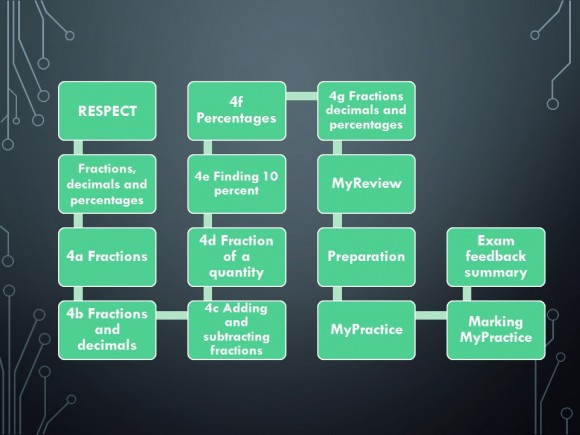The unit practice paper certainly presented the pupils with a serious challenge. Many of the pupils found understanding / decoding the actual question more difficult then maths required to solve it. As their teacher, I learnt that “decoding questions” is a skill I should allocate more time to in future units (incidentally, we have already targeted pupils who need support with this skill). Despite successfully completing a handful of very similar questions to the one shown below in class, under exam conditions, many of the pupils stalled. The class analysis shows that only 27% of the available marks were gained. In the post practice review, with very little support or clarification, Q7 was answered successfully by almost all pupils. Literacy in maths can not be escaped. I am pleased to report that the pupils didn’t breakdown, and moved onto the next question. A sign of their growing resilience.
The pupils must spend time practicing the skills taught in the lessons through the tasks set on MyMaths. Not all do enough for their personal needs. It is no surprise that the pupil with the biggest improvement had completed all the Mymaths tasks set, many two or three times.
Two points from the RESPECT pledge continue to dominate our learning conversations. The pupils maths resilience, (as demonstrated in the practice paper and in conversations with parents) has come on leaps and bounds. Our long term perseverance challenge is still improving their speed and accuracy of their basic numeracy, times tables in particular. Please quiz your children when and wherever possible; long car journeys, waiting in line, randomly and when making purchases.
Fractions, Decimals and Percentages
The unit discusses places where fractions are used in everyday life. For example one penny is one-hundredth of a pound and in telling the time one might say a quarter (of an hour) to four O’clock or half (an hour) past one O’clock. A day is a seventh of a week, and hour a twenty-fourth of a day, a minute a sixtieth of an hour and a second a sixtieth of a minute. It may be interesting to review the fractions that arise in your general conversation, time, money, dishing dinner, slicing cake or pizza. We know that most teenagers want more than their far share of pizza, that they will certainly moan if they don’t get at least their fair share.
The unit covers equivalent (equal) fractions, ordering fractions, converting simple fractions to decimals and ordering decimals. Adding and subtracting fractions are covered, then calculating fractions and percentages of an amount. Converting between fractions, decimals and percentages are covered in the final section. Lots of very useful life maths parents can support from home.
I would guess that the pupils are pleased to get back to just numbers, though I anticipate percentages will pose a few challenges. As we come up to Black Friday, go ahead and test them on the wonderful discounts that are available.





